#via latina
Explore tagged Tumblr posts
Text

Antigua Via Latina / The ancient Via Latina
In the middle of the Roman periphery, between the modern Via Appia and Via Tuscolana, a section of the 3rd mile of the ancient Via Latina is preserved in perfect condition.
It has ancient origins: the natural route, already followed in prehistoric times, was used by the Etruscans to colonise Campania in the 8th-6th centuries BC.
Definitely laid out by the Romans around the IV-III centuries B.C., it connected Rome with Capua, maintaining its importance throughout Antiquity. In fact, even in the Middle Ages, it was preferred as an access road to Naples because of its better preservation compared to the Appian Way and the presence of a number of Christian places of worship along the route..
Entering the Archaeological Park of the Tombs of the Via Latina, it is now possible to walk along a section of the original paving of the street. With a pleasant walk you can admire the rich tombs dating back to the I-II century A.D. that overlooked the route, which still have perfectly preserved polychrome decorations on the façades and inside: vaults covered with painted plaster and stucco, walls frescoed with funerary scenes and rich mosaic floors are still substantially intact in their original context.
From the street it is also possible to reach the Basilica of S. Stefano, a rare example of an early Christian building erected under the pontificate of Leo the Great in the middle of the 5th century.
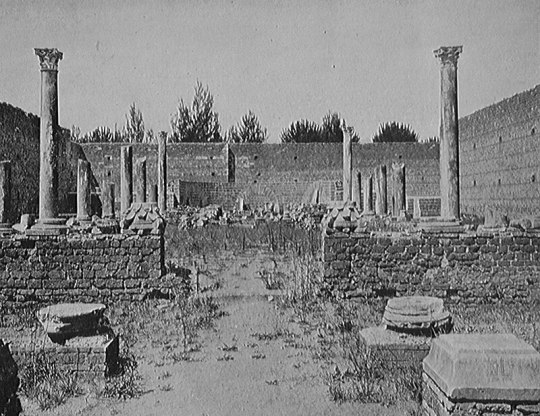
Santo Stefano en Vía Latina, restos parcialmente reconstruidos, 1911.
Santo Stefano in Via Latina, partially reconstructed remains, 1911.
The Archaeological Park of the Tombs of the Via Latina was created in 1879 following the acquisition by the State of a vast area in which important remains from Roman times had been discovered.
BARBERINI TOMB
The so-called Barberini Sepulchre, or Sepulchre of the Corneli. The funerary monument, dating from the 2nd century AD, consists of two above-ground floors and a hypogeum in an excellent state of preservation. The upper floor is covered by a ribbed vault completely covered with plaster painted with a red background and stucco elements. Groups of figures, winged victories on chariots, love affairs, birds, marine animals, mythological themes and architectural backgrounds can be recognised.


Sepulcro Barberini y su interior / Barberini Tomb and its interior
TOMB OF THE VALERI
The Tomb of the Valeri. The richly decorated underground rooms dating from the mid-2nd century AD are preserved, while the elevation is a hypothetical reconstruction dating from the mid-19th century. An elaborate white stucco covering, articulated in 35 medallions and panels, adorns the lunettes and the barrel vault of the underground room. The medallions depict Dionysian themes, female figures and sea animals, while in the central tondo there is a delicate-veiled figure on the back of a griffin, representing the deceased being carried to the afterlife.
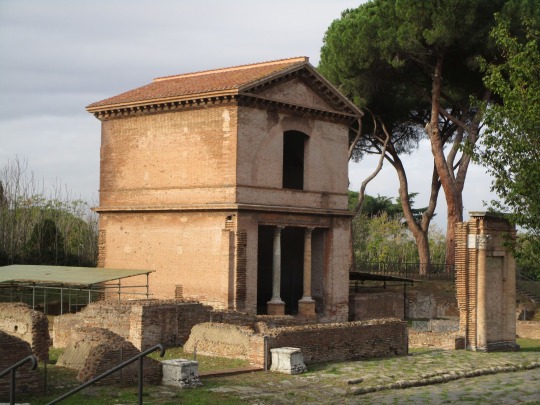
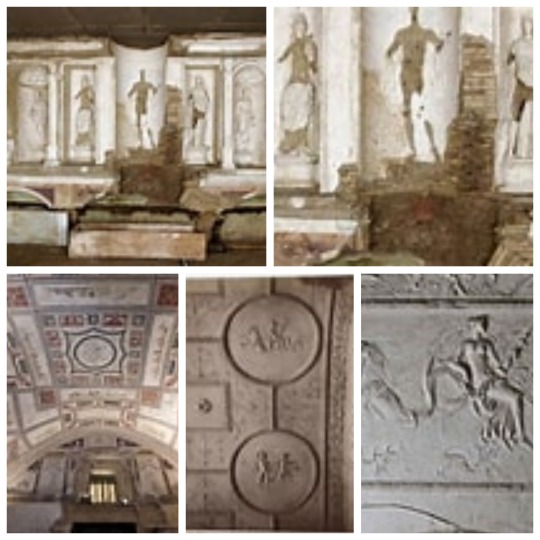
Tumba de los Valeri, exterior e interior / Tomb of the Valeri, exterior and interior
THE TOMB OF THE PANCRATII
The Tomb of the Pancratii. Much of the visible structure is a modern construction that protects the monument below by resting on the original 1st-2nd century AD walls, about a metre high. Upon entering the tomb, one can admire the beautifully decorated underground rooms, with mosaics on the floors and vaults and walls frescoed in bright colours and stucco in an excellent state of preservation. They depict mythological scenes, natural and architectural landscapes, images of women and animals. In the centre of one of the underground chambers is a large sarcophagus for two Greek marble depositions.
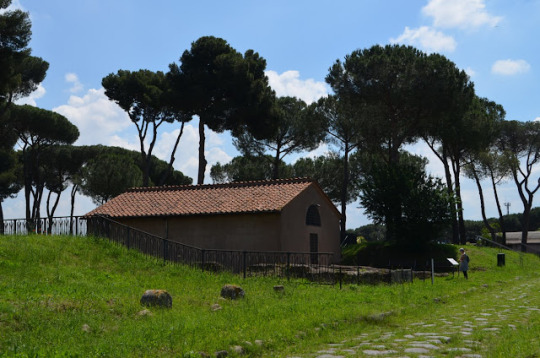

Sepulcro de los Pancracios, exterior e interior / Tomb of the Pancracios, exterior and interior
85 notes
·
View notes
Text


Scoperta durante i lavori di scavo al terzo miglio della via Latina, recentissima (venerdì 27 settembre 2024).
La notizia ripresa da Anticae Viae, pagina di divulgazione dedicata a Roma e alla classicità.
Il link vi illustra un po' di storia del luogo e di Santo Stefano sulla via Latina.
Forse è una testa apollinea, probabile datazione I d.C.
Dal profilo dell'archeologo Santino Sandro Cugno
#roma#italy#rome#italia#ancient rome#archeology#via latina#apollo#statue#scavi#excavation#classic art#storia di roma#paleochristian art#basilica#santo stefano sulla via latina#archeologia
2 notes
·
View notes
Text

15 notes
·
View notes
Text
It sucks when you learn something new which might be the answer to a question you've had for a while but you don't even know where to start to see if it really is the answer.
#liv won't shut up#the context: i am a white & from the us. but i have dark hair eyes & skin. dark enough skin that i get asked a lot if i'm latina. usually#latina (which i think matches my appearance the most) but i've gotten native american pakistani (okay that one makes no sense but whatever)#& a few others. thing is i know a lot of my family history. my family has been in the us for quite a few generations but before that my#ancestors were from england & scandinavia mainly though due to history i can assume i have french & german ancestry as well. & um these#countries arent known for dark complexions. so then ppl are always surprised. convo usually goes like this#person: where are you from?#me: the us#person: & your parents? what is your ancestry?#me: my family has been here for generations but before that they were from england & scandinavia mainly.#person: really? because you don't look like it. you look latina. where did your complexion come from?#me: idk how would i know?#well i recently learned about a group in scandinavia called the sami. they're originally from siberia but many moved to scandinavia#centuries ago. & they have darker complexions. so now i'm wondering if at some point i had ancestors that were sami from scandinavia#& if there genes just kept getting passed down until me#but man i do not have the time to figure that out#like i dont *need* to know i'll be fine. but i've always been curious & it would give me an answer to tell ppl that ask#also btw it isnt just white americans asking if i'm poc. lots of poc ask too. i'm working at a mexican restaurant & i get asked all the tim#there if i'm latina bc “i look like everyone else there”#but it would be nice to have an answer besides “idk” when someone asks why i have my complexion#at least i know what line it comes from. my dad & grandpa look like me too#& also got asked a lot if they were latino. even more than me. my grandpa is from southern arizona. we have a white american as heck last#name so everyone thought his dad was american & his mom mexican (nope). then he moved when he married my grandma to my grandmas#home town so then all of them saw this guy from arizona moving in with darker skin & also assumed he was at the least biracial.#then ppl thought my dad was biracial too bc he's the son of the random arizonan with darker skin#so i know wherever i got this gene comes from came via my grandpa
3 notes
·
View notes
Text

#shakira#shakira mebarak#bizarrap#celebs#celebrities#2023 premios billboard de la musica latina#2023 billboard awards#via twitter/x#twittwe#x#social media#post#october 2023
10 notes
·
View notes
Text



Ghetto Latina gilf had sum large buns 😩🍑 my eyes was poppin out my head 😭🍑🔥🔥 dm me for this full video 🔥🔥🔥 it’s $2 via cashapp/paypal/ Apple Pay
1K notes
·
View notes
Text
the boy is mine | lewis hamilton [3/3]
social media au. latina + singer!reader
summary — a certain formula 1 driver caught your attention, and you can't help but let the whole world know about your attraction. (read part one and two here)
face claim — rosalia
song — the boy is mine by ariana grande
warnings — none!
author's note — apologize that pt3 took so long!! i got sick lol. but here's the final part!! i love this series so much and i hope u guys enjoyed it as much as i loved making it!
all pictures taken from pinterest. credit to owners.

messages!

instagram!


liked by ynln, lewishamilton and 7,937 others
f1wagsupdates YN LN supporting Lewis Hamilton at the Belgium Grand Prix today!
via photographeruser
view all 256 comments
user1 omg yn wag debut 🙏🏼
user2 lewis already lurking in the likes 😭😭
user3 their smiles 😭🩷
user4 bringing her to the merc garage already.... chat how serious do we think they are
user5 user4 probably just friends. personally i do not see this progressing as an actual relationship
user6 user5 i hope not cause they look so adorable together though :(
user7 user6 honestly if yn hornily wrote "bed chem" about lewis then "guess" WITH lewis and still failed to get the man it'd be so hilarious lmfao
user6 user7 it'd be HIS loss though imagine fumbling someone like yn 🙏🏼
user7 user6 fair enough
instagram!






liked by pierregasly, carmenmmundt and 926,213 others
ynln george in the back bcs that pic didn't match the aesthetic of my feed
tagged lewishamilton, f1, mercedesamgf1 and georgerussell63
view all 10,638 comments
ynln also congrats on the win or whatever lewishamilton
lewishamilton ynln ouch
lewishamilton ynln congratulating me as a second thought? i regret inviting you already
ynln lewishamilton i would've been there either way 🙏🏼
lewishamilton ynln if i recall correctly you said showing up at the race is a bad idea and that people would talk
ynln lewishamilton i didn't say i wouldn't be there period 🙏🏼 i had to show otherwise you would have lost
lewishamilton ynln my good luck charm ❤️❤️ this is why i love you
ynln lewishamilton i know right you are soooo lucky to have me
user1 ynln lewishamilton damn should we leave????
user2 user1 FR LIKE YN ARE WE INTERRUPTING SOMETHING 😭😭
user3 ynln lewishamilton oh my god they are DATING dating i'm freaking out like crazy right now
user4 ynln lewishamilton SHE GOT THE BOY
user5 ynln lewishamilton omw to write a horny love song about my crush so he'd like me back brb 🏃🏻♀️🌬️
georgerussell63 i'm hurt yn and i already got dsq
user6 georgerussell63 LMFAO POOR GEORGE 😭😭
carmenmmundt loved talking to you we should hang out soon!!
ynln carmenmmundt would love to!! text me babe
user7 carmenmmundt ynln they're bffs already omg
user8 user7 mercedes wags have to stick together 🙏🏼
instagram!



liked by ameliadimz, ayame.p and 3,162,738 others
lewishamilton the win might be mine but this boy is forever hers ❤️
tagged ynln
view all 12,263 comments
ynln OKAYYYY
ynln i'm putting that caption in the song btw
lewishamilton ynln you can take full credit baby
ynln lewishamilton ofc i am you wouldn't be coming up with that clever ass caption if it wasn't me 🙏🏼
user1 ynln WHAT SONG
user2 ynln DON'T IGNORE US
user3 ynln she's so 😭😭
user4 THEY ARE HARD LAUNCHING EVERYBODY STAY FUCKING CALM
user5 this is so crazy we already seen them saying i love you on this app PUBLICLY and yet i still can't believe they are actually dating rn 😭😭
user6 user5 I KNOW RIGHT and to rhink this all started bcs she was down bad for this man 😭😭
user5 user6 she's giving me the courage to confess to my crush but i just KNOW as soon as i try i'd fumble it so bad

taglist — @seonghwaexile @totallynotluluu @omgsuperstarg @exotic-iris13 @formulaal @josephqunnies @book-obsesseds-world @st4rgirl-ellie @czennieszn
#formula 1#formula 1 x reader#f1#f1 smau#formula 1 x you#formula 1 x y/n#formula 1 x oc#formula 1 x female reader#formula 1 x latina!reader#formula 1 x singer!reader#f1 x yn#f1 x oc#f1 x you#f1 x reader#f1 x y/n#f1 x latina!reader#f1 x singer!reader#formula one x you#formula one x reader#formula one x y/n#formula one x oc#formula one x latina!reader#formula one x singer!reader#lewis hamilton#lewis hamilton x you#lewis hamilton x oc#lewis hamilton x reader#lewis hamilton x latina!reader#lewis hamilton x singer!reader
433 notes
·
View notes
Text








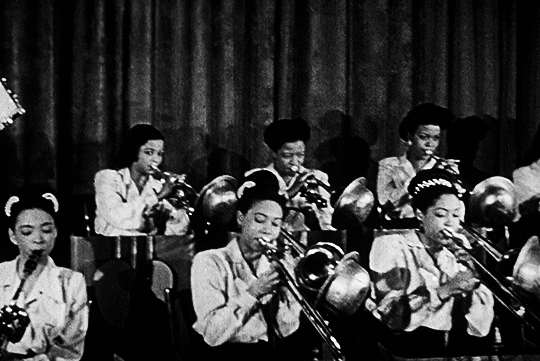

SHE'S CRAZY WITH THE HEAT — 1946 ft. The International Sweethearts of Rhythm
In 1946, William D. Alexander began the production of a series of one-reel shorts, half-hour featurettes and feature films that would serve a dual purpose. These black cast subjects would be released to theaters that welcomed African American audiences; concurrently, the music segments would be excerpted from the films and released as Soundies. Ultimately, sixteen of Alexander’s musical shorts reached the Panoram screen, spotlighting the bands of Lucky Millinder, Billy Eckstine, Henri Woode and the International Sweethearts of Rhythm. (Alexander actually produced four films with the Sweethearts, three ten-minute short subjects and one feature, although some of the performances turns up in more than one film; only three performances saw release as a Soundie.) The International Sweethearts of Rhythm grew out of a band formed in the 1930s at the Piney Woods Country Life School, an institution – in part an orphanage – for poor African American children. A member of the music department had apparently taken note of the success of Ina Ray Hutton’s Melodears and decided that an all-woman band composed of school members might lead to something special. While they performed locally, the ISR did not begin to hit its stride until it left Piney Woods and became a professional touring outfit in 1941. The band was certainly “international” in nature, and its ranks included African American, Latina, Chinese, Indian, White and Puerto Rican musicians. In 1941, Anna Mae Winburn joined the orchestra as front woman and featured vocalist. During the war years Maurice King joined the band as both arranger and band manager. Born Clarence King in 1911, King played reeds and later became a fine swing arranger. While here we recognize his composition and arrangement for the Sweethearts – he called this tune “She’s Crazy with the Heat ” – King is best known for his longtime association with Barry Gordy and Motown Records for which he served as director of artist development. He worked closely with vocal groups, teaching the singers how to voice and phrase together. “Maurice brought sophistication and class to Motown,” said session musician Johnny Trudell. By 1946, the Sweethearts was recognized as one of the finest African-American bands in jazz. They recorded for Guild and RCA Records, broadcast regularly for the Armed Forces Radio Service, and toured Europe entertaining the GIs. While much of the success was due to Maurice King’s arrangements, the band’s musicians were all strong, and a special nod must go to Viola Burnside, one of the most neglected tenor soloists of the 1940s. I chatted with my friend Roz Cron, a member of the Sweetheart’s reed section, shortly before her passing. When I thanked her for her contribution, she paused and said, “Yeah, we were one of the best, one of the very, very best.” (via Jazz on Film)
#classicfilmsource#femaledaily#filmedit#film#classicfilmedit#oldhollywoodedit#jazz#music#the international sweethearts of rhythm#she's crazy with the heat#1940s#mygifs*#soundies*
707 notes
·
View notes
Note
just wondering, any tips you'd recommend for learning latin? I've been thinking of learning it since it sounds pretty fun but I don't really know where to start with it
Tips:
When studying vocabulary, close your eyes and picture the meaning of a Latin word while saying it. So for dux, form a mental image of a leader leading his army. For monere, picture someone shaking their finger in warning. For sub, find an image that signifies the meaning to you--for me, it's a boat going under a bridge. Having an image will help your brain bypass the English word to think in Latin.
After translating a sentence, do the same thing. Reread it aloud, clearly picturing what is happening in the sentence. If it describes an action, you could try moving your body to mimic the action, or if it's a question, pretend you're asking a friend. Try different tones of voice and facial expressions to get the meaning across. Eventually, you should be able to understand some sentences on the first read, without translating.
If you ever have the opportunity to practice speaking Latin with someone else, do it! It's so good for your comprehension.
Getting started:
Most textbooks will assume you're starting from scratch. Here are some different options to suit different learning needs:
Latina Lingua per se Illustrata uses no English at all. It tells a story in Latin, starting out with very simple sentences and progressing to harder ones. I think it's brilliant, but it may be difficult if you don't have a teacher.
Via Latina has been recommended to me as a similar idea, but using Latin primary sources rather than a story. I haven't personally used it, but it sounds amazing.
Henle is a four-year course appropriate for high school or college students. It's the one I used, but I don't think it's the best course out there. It is available online though, and the companion grammar is excellent.
Wheelock is a one-year textbook appropriate for college students. I only used it briefly, but my husband loves it. It covers roughly the same material as Henle in just one book, so it's denser for sure.
Regardless of what you're using, it's always helpful to be able to ask someone for help when you're stuck, so try to track down a "Latin mentor" if you can!
Best of luck.
183 notes
·
View notes
Text
CARVILIO'S RING
EL ANILLO DE CARVILIO
L'ANELLO DI CARVILIO



(English / Español / Italiano)
The ring of Carvilius, found on the finger of a Roman matron during excavations on the Via Latina, bears witness to the profound pain and at the same time the great love of a mother for her son.
In 2000, on the Via Latina on the south-eastern outskirts of Rome, while excavations were being carried out to remove a pylon from a plot of land, steps leading to a sealed doorway were discovered. Beyond the door was a Roman tomb from the 1st century AD, still intact.
The tomb, measuring 9 square metres, houses two marble sarcophagi. In the first lies "Carvilio Gemello"; in the other, "Aebutia Quarta".
The bodies of the two deceased were well preserved, especially that of the young man, probably due to embalming and the favourable microclimatic conditions of the tomb.
In the sarcophagus of Aebutia, a wealthy Roman matron, only the skeleton has been found, but also the garlands of flowers (lilium, roses and violets) that adorned the deceased, the silk tunic she wore and the beautiful red wig she wore on her head, made of human hair, plant fibres and animal hair.
Neither of the deceased wore the traditional coin in their mouths, as was the custom in Rome, suggesting that Carvilius and Aebutia were followers of the Egyptian cult of Isis.
Wigs similar to the one worn by the Roman noblewoman have also been found in other burials, while the band ring worn by Aebutia on her finger is original and absolutely unique, a ring that has aroused great astonishment among archaeologists. An object of great beauty and incalculable value for its uniqueness and emotional value.
Under the bezel (part of the ring, or other jewel, where the gem is placed) of rock-crystal, worked "cabochon", is a mini-bust of Carvilius, who died at the age of 18 years and three months. The young man depicted has a bare torso; his curly hair, thin lips and aquiline nose are evident.
Due to the brightness caused by the glass lens, Carvilio's image gains depth when viewed.
Aebutia had had two children by different husbands. Carvilio was born of her first marriage to Titus Carvilio, of the Sergia family. From her second husband, however, she had a daughter, Antestia Balbina, who took care of his burial.
Aebutia died a few years after Carvilius, at the age of 40-45. In her sarcophagus there were also some baby bones, suggesting that she was pregnant at the time of her death.
The magnificent ring is now in the Archaeological Museum of Palestrina in Rome.
Por Anna Rita Rossi
------------------------------------------------------------------------------
El anillo de Carvilio, hallado en el dedo de una matrona romana durante unas excavaciones en la vía Latina, atestigua el profundo dolor y al mismo tiempo el gran amor de una madre por su hijo.
En el año 2000, en la vía Latina, en la periferia sureste de Roma, mientras se realizaban excavaciones para retirar un pilón de un terreno, aparecieron unos escalones que conducían a una puerta sellada. Más allá de la puerta, una tumba romana del siglo I d.C., aún intacta.
La tumba, de 9 metros cuadrados, alberga dos sarcófagos de mármol. En el primero yace "Carvilio Gemello"; en el otro, "Aebutia Quarta".
Los cuerpos de los dos difuntos estaban bien conservados, sobre todo el del joven, probablemente debido al embalsamamiento y a las favorables condiciones microclimáticas de la tumba.
En el sarcófago de Aebutia, una rica matrona romana, sólo se ha encontrado el esqueleto, pero también las guirnaldas de flores (lilium, rosas y violetas) que adornaban a la difunta, la túnica de seda que vestía y la preciosa peluca roja que llevaba en la cabeza, hecha de cabello humano, fibras vegetales y pelo de animal.
Ninguno de los difuntos llevaba la tradicional moneda en la boca, como era costumbre en Roma, lo que sugiere que Carvilio y Aebutia eran seguidores del culto egipcio a Isis.
También se han encontrado pelucas similares a la que llevaba la noble romana en otros enterramientos, mientras que original y absolutamente único es el anillo de banda que lucía Aebutia en el dedo, un anillo que ha despertado gran asombro entre los arqueólogos. Un objeto de gran belleza y de incalculable valor por su singularidad y su valor emocional.
Bajo el bisel (parte del anillo, u otra joya, donde se coloca la gema) de cristal de roca, trabajado "a cabujón", hay un mini busto de Carvilio, que murió a la edad de 18 años y tres meses. El joven representado tiene el torso desnudo; son evidentes su pelo rizado, sus labios finos y su nariz aguileña.
Debido al brillo causado por la lente de cristal, la imagen de Carvilio gana profundidad al observarla.
Aebutia había tenido dos hijos de diferentes maridos. Carvilio nació de su primer matrimonio con Tito Carvilio, de la familia Sergia. De su segundo marido, sin embargo, tuvo una hija, Antestia Balbina, que se encargó de su entierro.
Aebutia murió unos años después de Carvilio, a la edad de 40-45 años. En su sarcófago había también algunos huesos de bebé, lo que sugiere que estaba embarazada en el momento de su muerte.
El magnífico anillo se conserva hoy en el Museo Arqueológico de Palestrina, en Roma.
Por Anna Rita Rossi
------------------------------------------------------------------------------
L'anello di Carvilio, trovato al dito di un'ostetrica romana durante gli scavi sulla via Latina, testimonia il profondo dolore e allo stesso tempo il grande amore di una madre per suo figlio.
Nel 2000, sulla via Latina, nella periferia sud-est di Roma, mentre si effettuavano scavi per rimuovere un pilone da un terreno, apparvero dei gradini che conducevano ad una porta sigillata. Oltre la porta, una tomba romana del I secolo d.C., ancora intatta.
La tomba, che misura 9 metri quadrati, ospita due sarcofagi di marmo. Nel primo giace "Carvilio Gemello"; nell'altro, "Aebutia Quarta".
I corpi dei due defunti erano ben conservati, soprattutto quello del giovane, probabilmente grazie all'imbalsamazione e alle favorevoli condizioni microclimatiche della tomba.
Endel sarcofago di Aebutia, una ricca matrona romana, è stato ritrovato solo lo scheletro, ma anche le ghirlande di fiori (lilium, rose e viole) che adornavano la defunta, la tunica di seta che indossava e la bella parrucca rossa che portava in testa, fatta di capelli umani, fibre vegetali e peli animali.
Nessuno dei due defunti portava in bocca la tradizionale moneta, come si usava a Roma, suggerendo che Carvilius e Aebutia fossero seguaci del culto egizio di Iside.
Parrucche simili a quella indossata dalla nobildonna romana sono state ritrovate anche in altre sepolture, mentre originale e assolutamente unico è l'anello a fascia che Aebutia portava al dito e che ha suscitato grande stupore tra gli archeologi. Un oggetto di grande bellezza e di incalcolabile valore per la sua unicità e il suo valore affettivo.
Sotto il castone (parte dell'anello, o di un altro gioiello, in cui è inserita la gemma) di cristallo di rocca, lavorato "a cabochon", si trova un mini-busto di Carvilius, morto all'età di 18 anni e tre mesi. Il giovane raffigurato ha il busto nudo; sono evidenti i capelli ricci, le labbra sottili e il naso aquilino.
Grazie alla luminosità dovuta alla lente di vetro, l'immagine di Carvilio acquista profondità quando viene osservata.
Aebutia aveva avuto due figli da mariti diversi. Dal primo matrimonio con Tito Carvilio, della famiglia Sergia, nacque Carvilio. Dal secondo marito, invece, ebbe una figlia, Antestia Balbina, che si occupò della sua sepoltura.
Aebutia morì qualche anno dopo Carvilius, all'età di 40-45 anni. Nel suo sarcofago c'erano anche alcune ossa di bambino, il che fa pensare che fosse incinta al momento della morte.
Il magnifico anello si trova oggi nel Museo Archeologico di Palestrina a Roma.
Por Anna Rita Rossi
0 notes
Text
I'm unimpressed
Whenever any leftist interacts with me, it's always the same. They posture and laugh at me for being a conservative. They look down on me. They cite false statistics or allegations fed to them by propaganda networks. They exhibit arrogance, smug superiority and overwhelming condescension without any knowledge, understanding or moral fortitude to back it up. When everything else fails, they resort to the New Communist slogan of "racist, sexist, homophobic, transphobic".

To which I respond: My best friends include a black man from Trinidad, a Latina woman who immigrated to the US at the age of five, a man with Aspergers and severe anxiety disorder, a black lesbian, an Indian South African, a Chinese American woman, an octogenarian gay man, a Cameroonian man and a Saudi Arabian man who describes himself as pansexual. And a whole bunch of really awesome white people who are not racist, sexist, homophobic or transphobic.
I'm gay. I voted for Trump because i don't believe the Democrats love me. I don't need them to love me. I don't want their love. They love sin and the embrace of dark triad behavior as their paragon for leadership skills, totalitarian thought control, the destruction of society, and they seek to make atheism the norm. They love the denigration of any individual that defies them, disagrees with their tactics, calls out their lies...they hate truthtellers. They hate anyone that places God as an imperative and sacred texts as crucial to their ethical conduct. They hate anyone that threatens their power and they believe in encouraging public vitriol to meet their needs. They believe in the destruction of the nuclear family. They encourage the worship of and dependence on the state to replace the family. They believe in a direct pipeline between the White House and newly established propaganda networks that cater only to the Democrat Party and the CIA. They believe in reputation destruction using those propaganda networks. They believe they have the right to assassinate Trump and anyone else who they deem a threat to their power. They have initiated the single worst attack on children in the history of our country via human trafficking and institutionalized rape ordered by the CIA. They normalized embezzlement, money laundering and inflationary tax on an unheard of scale to further demoralize the populace and inflate their own bank accounts. They conduct constant psychological war against their own people, which extends to perverting the minds of their children without their knowledge via the trans cult, the gender theory cult, and the DEI/Critical Race Theory cult.
On the issue of transphobia, I certainly don't endorse violence. But it is not violence to state that all trans people are mentally ill and they must be stopped from mutilation of children and sterilizing minors with puberty blockers, from demanding forced speech regarding their delusions, from using public funds to procure trans surgeries and from public attaining positions of power such as the Secretary of Health where they may spread their perverse cult directives causing psychological and physiological arm to adults and children alike.
They believe in these things because they want to secure a future for an elite minority that takes everything for itself, enslaves the rest of the populace, and convinces the populace that their astronomical greed is justifiable and that their destructive policies that result in totalitarian hell should be embraced as godly, necessary, and protective measures. They mockingly wear a mask of sympathy, compassion and the moniker of "social justice" which is nothing more than a code for "thought police" whose sole purpose is to implant hatred for political opponents and self hatred amongst whites, any minorities with religious sensibilities, and the intelligentia at large.
The future that they desire is a constant hell of pervasive misery and support of a one party state, supported by thoughtless government worship, slogan repetition, dehumanization of political opposition, desensitization to violence to meet the ends of the party's plans, mentacide, hatred of the past and all the accomplishments of Western Civilization, physical degradation and obesity from technological addiction and slow chemical poisoning from tainted food and lastly lowering testosterone via pbthalates.
I'm a gay white male and that doesn't play into my vote. It shouldn't. The body you're born with shouldn't determine your vote. Your party has done absolutely nothing for me. You have never done anything to help me. I am happy to fight you to the bitter end in any way I can to stop you from the communist genocide you so lovingly long for.
#gay#gay conservative#religion#communism#government#MAGA2024#MAGA#Trump#Donald Trump#Joe Biden#Democrats#Kamala Harris#authoritarianism#totalitarianism#control#news#fake news#liberals#liberalism#cult#election 2024#congress#CIA#politics#america#history#DEI#critical race theory#CRT#gender theory
60 notes
·
View notes
Text

7 notes
·
View notes
Text
Shakira via Instagram Stories. (Oct 6, 2023)
#shakira#shakira mebarak#celebs#celebrities#2023 latin billboard awards#2023 premios billboard de la musica latina#el jefe#brzp music sessions vol. 53#via instagram stories#ig stories#instagram#social media#video#october 2023
8 notes
·
View notes
Text
I have neglected this blog for a few weeks, but I will get back to queueing soon. I am not ignoring anyone.
I want to say one thing.
When David Duchovny endorsed Kamala Harris there were a lot of Trump supporters in his comments complaining and using Mulder (fictional fucking character btw) as a scapegoat for their hatred.
I want to make it exceptionally clear that this blog is run by a queer latina. I want to make it clear that if you are a Trump supporter, are anti-abortion, a misogynist, racist, a transphobe, a homophobe, a xenophobe, a zionsist, a climate change denier, an anti-vaxxer, or in any other way a right wing extremist you are not welcome on this blog.
And while Mulder is not real, he would absolutely NOT be a Trump supporter, it's actually canon via the revival if you knew jack shit about the show you claim to enjoy.
110 notes
·
View notes
Text
[...] Trump pensa che gli europei siano una manica di parassiti e rammolliti da cui spera di spillare qualche dollaro con le tariffe. Sa poco o nulla della seconda guerra mondiale, ma sa bene i miliardi che spende per mantenere il baraccone della Nato e gli anfibi nel vecchio continente. Meglio, se levano le tende ci fanno solo un favore. A casa loro nel frattempo, lui e il suo boss Musk stanno tagliando costi con la falce per poi tagliare le tasse ai ricchi. Son scalmanati, come se sapessero di avere vita breve. Trump sta calpestando il potere legislativo e giudiziario e cioè la costituzione su cui ha giurato. Molti dei suoi ordini esecutivi sono già stati impallinati e siamo solo all’inizio di una guerra civile perlomeno di scartoffie. Stanno poi venendo a galla molte balle elettorali. Il prezzo delle uova segna record storici e molti maga cowboy si trovano senza un dollaro e senza braccia. Anche chi lo ha seguito soffre. I latino americani stanno boicottando in massa la Coca Cola colpevole di aver tradito i suoi dipendenti dalla pelle scura facendoli deportare. È la coriacea presidentessa messicana a guidare la resistenza latina e al nord non va meglio. I canadesi minacciati coi dazi stanno boicottando in massa tutti i prodotti americani, comprano locale e già si abbassano le prime saracinesche lungo il confine. Altro che cinquantunesimo stato, dito medio alzato verso il cielo. Anche i pinguini della Groenlandia e gli alligatori di Panama non hanno nessuna intenzione di sottomettersi all’egolatra arancione e le strade statunitense si stanno riempiendo di schiuma. Quanto ad Elon Musk, è messo ancora peggio. Tutte le teste che sta tagliando non si rassegnano a rotolare via e da quando ha fatto outing col saluto nazista, le sue aziende stanno crollando vertiginosamente ovunque. Le Tesla invece di comprarle le vandalizzano quando le trovano per strada e da paladino social è diventato il protagonista del complottismo nero che ha sempre sparso per il globo. Quello americano più che un declino imperiale, è un’implosione. A fregarli è il fanatismo capitalistico e finché non lo capiranno bye bye. Poi ci sono gli altri. La Russia esce dal pantano ucraino col petto in fuori e pure villoso. Si è fatta nuovi amichetti ad est e lo zar lo smuove giusto il padreterno. Checche ne dica la tecnocrazia del vecchio continente, Putin non ha mai voluto invadere l’Europa o non ci riuscirebbe nemmeno. L’unica cosa che pretende è che non gli piazzino i missili sotto al balcone di casa come hanno provato a fare gli americani-woke seguiti da quegli ipocriti e rammolliti degli europei. Un giorno amiconi, il giorno dopo sponsor di una autolesionista guerra per procura. Poi c’è la Cina che invece di parlare lavora. Producono già le macchine elettriche migliori al mondo e anche sull’Intelligenza Artificiale han fatto crollare le illusioni statunitensi. La Cina è già il nuovo leader mondiale anche se il mondo fa fatica a capirlo. Soprattutto noi occidentali, abituati a stare al guinzaglio di quegli spacconi e chiassosi degli americani. La Cina non crede nell’egemonia ma in mondo multipolare e si sta affermando ovunque con moderazione e concretezza. Invece che alla guerra pensa agli appalti, invece che a distruggere a costruire, invece che ad imporsi a convincere. Un approccio anche culturale più intelligente e salubre anche se nonostante la mitezza, la Cina sta facendo passi da gigante anche a livello militare. Solo deterrenza oppure preludio di un possibile scontro coi loro predecessori. La salvezza dell’Europa parte da qui, dalla presa d’atto del nuovo scenario globale. [...]
Tommaso Merlo: La fine o l’inizio dell’Europa
- Via
29 notes
·
View notes
Text


Propaganda:
Sanji
-Sanji one piece es literalmente el pechurina con papa como no va a ser latino ese hombre cocina escuchando reggaeton y baladas de señora
-Sanji es boricua porque te garantizo que él usa adobo goya para cocinar
-Propaganda de la mamá del admin: "me gusta que el papá le diga "Berenjenita"...me hizo llorar" (se vio OPLA)
Candy Candy
-Candy White Andrew (Candy Candy) La mona china número 1 entre las mamis de latino América, visitó México y salió traumada de ahí. He escuchado a amigos de mi madre decir de manera no irónica que Candy era su amor platónico de la infancia. Vamos, tiene acento argentino. Yo sé que quieren, déjenla volverse latina.
-Candy Candy, básicamente la protagonista de una telenovela de chica pobre/chico rico y nada es más latinoamericano qué eso
-También Candy candy porque hizo llorar a mi mamá y mis tías (y a las de toda latinoamérica) cuando murió antony. Iconic
-Candy de Candy Cabdy , voy a quedsr como tremenda tarada si es latina y yo ni sabía pero se lo merece
CANDY candy ya esta aqui?? Siento como no vi a candy en esa lista y de verdad no puede ser porque como es que mis papas tienen su opinion de candy aunque son divorciados y se casaron otra vez y también los papas nuevos también tienen algo de decir de candy. Creo que ella es del anime de 1979 o algo. El punto es que candy debe ser latina
Candy candy otra vez. Toda via si mi papa dice “pero porque candy tuvo dos novios? No es bueno engañar la gente smh” mi mama y mi madrastra se quejan taaaanto no se puede creer
BONUS PROPAGANDA: -Terry de Candy Candy para argentino Explicación: es un tremendo hijo de puta pero es gracioso (saludos desde argentina)
292 notes
·
View notes